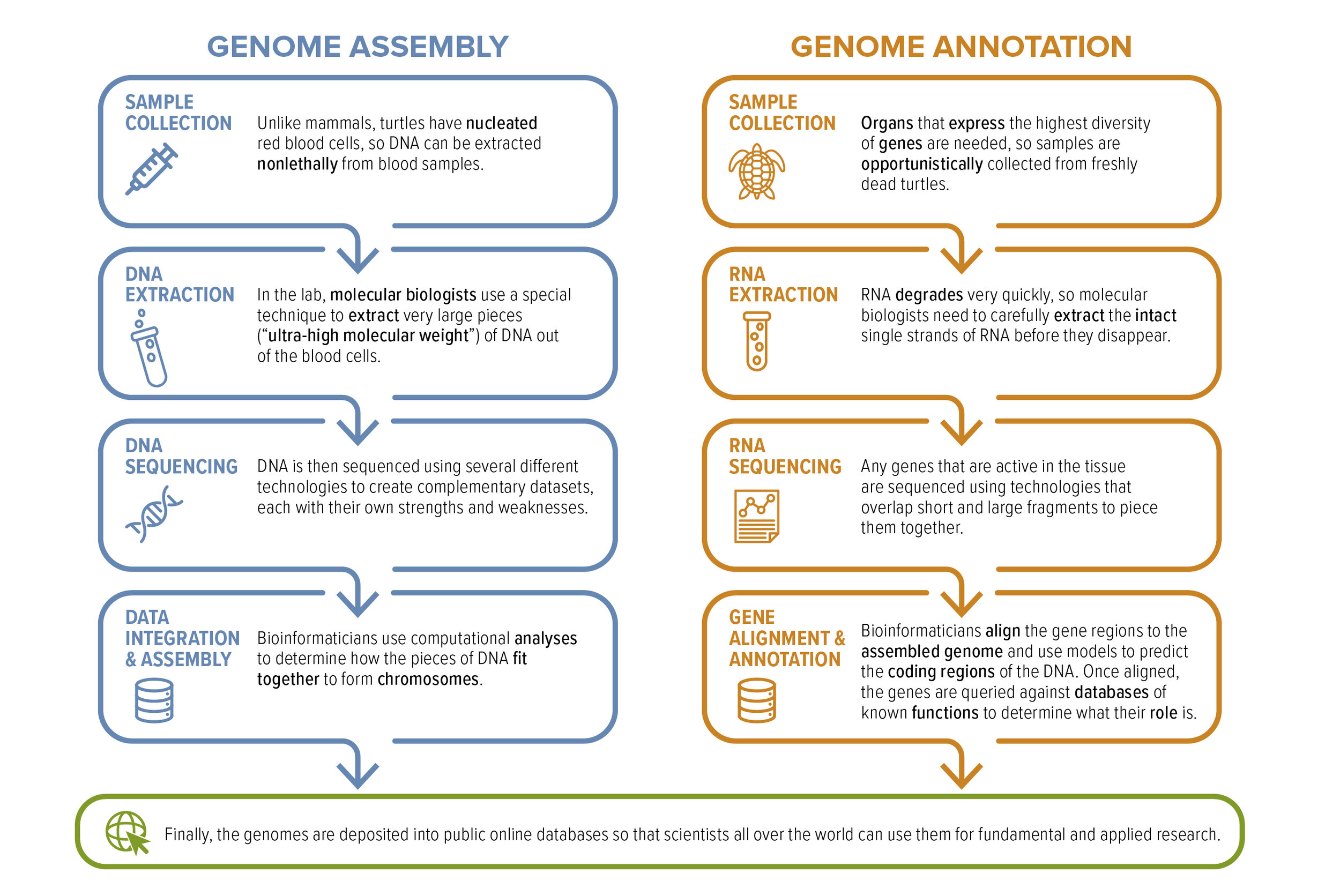What Makes a Sea Turtle?
By Blair P. Bentley, Peter H. Dutton, and Lisa M. Komoroske
A leatherback hatchling crawls to sea on Grande Riviere Beach, Trinidad. © Ben J. Hicks/benjhicks.com
Deep within the cells of sea turtles are signals of their evolutionary past, indications of their ability to adapt to changing environments, and fundamental building blocks that make them what they are. The DNA that composes the genetic blueprint for making a sea turtle is called its genome. Until recently, scientists had been able to gain only glimpses of important aspects of sea turtle biology from small pieces of DNA, leaving much still unknown in humans’ deeper understanding of those animals.
But genetic science has advanced at a lightning pace; new and emerging technologies now allow the rapid and affordable sequencing of entire genomes. The first draft human genome cost an estimated US$300 million and took more than a decade to complete. Today, you can swab your cheek, have your genome sequenced for less than US$1,000, and see the results in a few days! Although trickier for wild organisms, collaborative efforts to sequence the world’s biodiversity are making amazing strides. The Vertebrate Genome Project (VGP) is one such effort; it aims to create near error-free genomes for approximately 70,000 wild animal species. VGP’s reference genomes for the leatherback and green sea turtles were completed in 2020, with downstream analyses now underway.
HOW DO YOU MAKE A GENOME?
A key feature of today’s genetic technology is the ability to sequence very large stretches of DNA (100,000+ long nucleotide segments). Sea turtle genomes have around 2.1 billion base pairs to assemble, so piecing those complex genome puzzles together is still a laborious and expensive task. It requires the collaboration of field biologists and veterinarians to collect the samples, of laboratory molecular scientists to extract and sequence the DNA, and of data analysts (bioinformaticians) to put all the pieces together. Genome construction starts with an extremely high-quality tissue sample—one in which the DNA is intact in very large segments; thus, acquiring such a sample for an endangered species in the wild is no small feat. Tissues must be collected under challenging field conditions and without causing any negative effects to living animals. For the leatherback genome referenced herein, blood was collected from a male turtle sampled as part of the National Oceanic and Atmospheric Administration (NOAA) in-water research efforts in Monterey Bay, California. To fully annotate the genome, RNA from key organs was also needed. Such tissues are even more sensitive to degradation; because they cannot ethically be taken from live turtles, RNA was obtained from recently deceased animals at the St. Croix Leatherback Project at the Sandy Point National Wildlife Refuge in the U.S. Virgin Islands and at the New England Aquarium in Boston. The figure below shows how the work of molecular scientists and bioinformaticians complete the process of genome definition once high-quality DNA samples have been collected in the field.
WHAT CAN WE LEARN FROM SEA TURTLE GENOMES?
The new whole genomes provide mountains of information about leatherback and green turtles and can help scientists understand how (and which) genes help to fight diseases, to facilitate temperature-dependent sex determination, or to assist turtles as they navigate across entire oceans. Genomes can also help scientists to track the history of the species over millennia, to map past population expansions and contractions, and to monitor genetic erosion (a loss of genetic diversity that occurs when a species’ population declines). Knowing the latter can help scientists to determine how vulnerable a species may be to climate change, disease, and other threats; how much inbreeding is occurring; and whether deleterious genes that can affect survival rates of the species may have accumulated over time.
These new, high-quality genomes will allow for the comparison of multiple sea turtle species and will help scientists to understand what differentiates them. The genomes will also provide future studies with an immensely useful reference that can allow investigation into population comparisons within a given species; such investigations could be of enormous benefit to conservation efforts worldwide.
Modern leatherbacks have unique characteristics accumulated over the ~75 million years of evolution since they diverged from the other sea turtles. They lack the hard carapace typically associated with green turtles and their cousins. They are also able to dive to great depths, migrate vast distances, and tolerate much colder conditions than can other turtle species. All of the genetic code that makes such behaviors possible is now in the hands of genetic scientists! By comparing the new leatherback and green turtle genomes with other freshwater turtle genomes, it is now possible for scientists to delineate the genes associated with adaptations to salt water, thereby getting to the heart of what makes a sea turtle a sea turtle.
Conceptual overview of how sea turtle genomes are created.
This article originally appeared in SWOT Report, vol. 16 (2021). Click here to download the complete article as a PDF.



